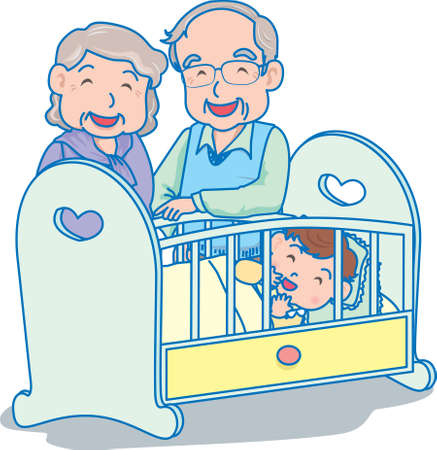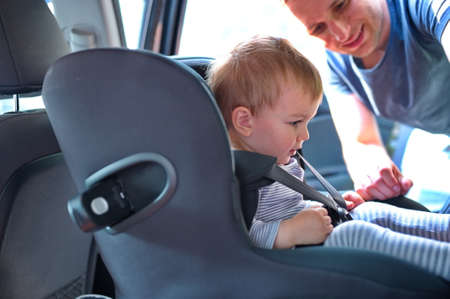Introduction: The Importance of Car Seat Safety
When it comes to the safety and wellbeing of children in vehicles, proper car seat use is absolutely vital—especially for grandparents and childminders in the UK. As families increasingly rely on extended family members and trusted carers for school runs, day trips, or weekend outings, understanding the latest legal requirements and best practices around car seats isn’t just a matter of compliance; it’s an essential part of keeping little ones safe on every journey. For many grandparents and childminders, car seat laws may have changed significantly since their own children were young. This makes it all the more important to stay informed and ensure every journey meets current safety standards. Not only does following these guidelines help prevent injury in the event of an accident, but it also provides parents with reassurance, knowing their children are travelling securely—even when they aren’t there themselves. In this article, we’ll explore why car seat safety matters so much for those caring for children in the UK, along with an overview of your legal responsibilities as a grandparent or childminder behind the wheel.
2. The Legal Requirements: Understanding UK Car Seat Laws
For grandparents and childminders who regularly transport children, understanding the UKs car seat laws is crucial for both safety and compliance. Current legislation is clear about when and how children must be secured in a vehicle. Here’s what you need to know:
| Requirement | Details |
|---|---|
| Age | Children must use a child car seat until they are 12 years old or 135cm tall, whichever comes first. |
| Height | If a child reaches 135cm before turning 12, they can legally use an adult seat belt. |
| Weight | The type of car seat required depends on the childs weight category (see below). |
Car Seat Categories by Weight
| Group | Child Weight | Type of Seat |
|---|---|---|
| Group 0+ | Birth to 13kg | Rear-facing baby seat |
| Group 1 | 9-18kg | Forward or rear-facing child seat with harness |
| Group 2/3 | 15-36kg | Booster seat or cushion with adult seat belt |
Your Legal Responsibilities as a Driver
The driver is legally responsible for ensuring that every child under 14 is correctly restrained in an appropriate car seat or booster. Failure to comply could result in a fine of up to £500. Always check the manufacturers instructions for proper installation and never use a rear-facing seat in front of an active airbag.

3. Choosing the Right Car Seat: Guidance for Caregivers
Selecting the appropriate car seat is crucial for ensuring a childs safety on the road. In the UK, the law requires that children use a car seat until they are 12 years old or 135 cm tall—whichever comes first. Grandparents and childminders often look after children of varying ages, heights, and weights, so its important to understand how to choose seats that fit each childs needs.
Types of Car Seats by Childs Age and Size
| Stage | Approximate Age/Size | Type of Car Seat |
|---|---|---|
| Group 0+/Infant Carrier | Birth to 13kg (up to 12-15 months) | Rear-facing baby seat |
| Group 1 | 9-18kg (9 months – 4 years) | Forward/rear-facing seat with harness |
| Group 2/3 | 15-36kg (4-12 years) | High-back booster or booster cushion |
Key Considerations for Grandparents and Childminders
- Check Compatibility: Make sure the car seat fits both your vehicle and the child’s size. Not all car seats are suitable for every car model.
- Adjustability: If you care for multiple children, consider adjustable or multi-group seats that can be adapted as children grow.
- Ease of Installation: Look for seats with ISOFIX attachments or clear instructions to reduce installation errors.
- Expiry Dates: Car seats have a shelf life—check for wear and tear or expired models, especially if using hand-me-downs.
- Simplicity: Choose a seat thats easy to adjust and clean, which is especially helpful when looking after several children.
Tips for Multiple Children in Your Care
- If you transport children of different ages, keep both rear-facing and forward-facing options available.
- Label each seat for specific children if possible, to avoid confusion and ensure correct fitting every time.
- If space allows, store an extra booster cushion in your car boot for older children who may visit occasionally.
- Always double-check straps and harnesses before every journey—even if the child was just in the seat earlier that day.
Remember:
The right car seat protects against injury in case of an accident. Taking time to select the proper type ensures compliance with UK law and peace of mind on every journey with your little passengers.
4. Fitting and Installation: Avoiding Common Pitfalls
Correctly fitting and installing a child car seat is crucial for safety, yet it can feel daunting, especially with so many car seat models and vehicle types on UK roads. Grandparents and childminders often use different cars, so its vital to know the general principles and avoid frequent mistakes. This section provides clear instructions and practical tips tailored to everyday scenarios you may face.
Choosing the Right Installation Method
The two primary installation methods in the UK are ISOFIX and seat belt fitting. Always check both your car manual and the car seat manufacturer’s instructions before starting.
| Installation Type | When to Use | Key Tips |
|---|---|---|
| ISOFIX | If your car has ISOFIX anchor points (most cars post-2006) | Ensure connectors click into place; check for green indicators; never mix ISOFIX with a seatbelt unless specified. |
| Seat Belt | If no ISOFIX or using older vehicles | Route belt exactly as shown in instructions; remove all twists; lock the belt tightly. |
Fitting Best Practices for Everyday Scenarios
- Check Compatibility: Not all seats fit every car. Test before buying or use in-store fitting services.
- Positioning: The safest spot is usually the rear middle seat, but only if there’s a full-size seat belt or ISOFIX point.
- Tightness: The seat should not move more than 2.5cm side-to-side or front-to-back when installed.
- No Bulky Clothing: Remove children’s coats before strapping them in for a snug harness fit.
- Avoid Used Car Seats: Unless you are sure of their history and they meet current safety standards.
Common Mistakes to Avoid
- Incorrect Harness Height: For rear-facing seats, straps should be at or below shoulder level; for forward-facing, at or above shoulders.
- Buckle Crunch: Ensure the seatbelt buckle does not rest against the car seat frame, which can compromise safety in an impact.
- Loose Harness: The harness should be tight enough that you can only fit two fingers between it and your child’s collarbone.
- Poor Angle for Infant Carriers: Most have an angle indicator – always check this, especially if swapping between cars frequently.
Practical Tip for Grandparents and Childminders
If you regularly swap car seats between different vehicles, keep a checklist handy and schedule periodic re-checks. Many local councils offer free checks—take advantage of these services to ensure ongoing compliance with UK law and best safety practices.
5. Transporting Children with Special Needs or Unique Circumstances
When caring for children who have disabilities or specific health conditions, or when using alternative forms of transport such as taxis and minibuses, grandparents and childminders must be aware of special legal requirements and practical guidance to ensure every child’s safety.
Children with Disabilities or Medical Conditions
If a child has a disability or medical condition that makes the use of standard car seats unsuitable, UK law allows for certain exemptions. However, this does not mean safety can be compromised. Instead, it is crucial to seek a specialist restraint system, which may include bespoke harnesses or postural supports recommended by healthcare professionals. Always ask your GP or occupational therapist for advice before travelling, and ensure that any adapted restraint meets the relevant safety standards (such as ECE R44/04 or i-Size regulations).
Legal Exemptions at a Glance
| Situation | Required Action/Documentation |
|---|---|
| Disability prevents use of standard car seat | Medical exemption certificate from GP; use of approved specialist restraint if possible |
| Short-term medical condition (e.g., leg in plaster) | Written advice from healthcare provider; safest arrangement possible in vehicle |
Taxis, Private Hire Vehicles, and Minibuses
UK law recognises that not all vehicles are equipped for car seat installation, particularly when using taxis or private hire vehicles. In these cases, different rules apply:
- Taxis and Private Hire Cars: Children under 3 may travel without a car seat only in the rear seats and only if one is not available. Children aged 3 and over must use an adult seat belt in the rear if a suitable car seat is not present.
- Minibuses: If child restraints are available, they must be used. Otherwise, children over 3 should wear an adult seat belt.
Quick Reference Table: Car Seat Requirements in Alternative Vehicles
| Vehicle Type | Ages < 3 Years | Ages 3–11 Years (Under 135cm) | Ages 12+ or Over 135cm |
|---|---|---|---|
| Taxis/Private Hire (Rear Seat) | No car seat required; child must sit in back | Adult belt if no car seat available | Adult belt |
| Minibus/Coach (Rear Seat) | No car seat required; sit in back | Adult belt if no car seat available | Adult belt |
| Family Car (All Seats) | Approved child car seat required unless exempted for medical reasons | Approved child car seat required unless exempted for medical reasons | Adult belt |
Key Takeaway for Caregivers:
If you are ever unsure about what is legally required, especially in unique situations involving medical needs or public vehicles, always check current government guidance (Gov.uk) and consult with relevant professionals. Prioritise planning ahead so that every journey remains safe, legal, and comfortable for all children under your care.
6. Penalties and Consequences: What Happens if You Don’t Comply
Understanding the penalties and consequences of not following UK car seat laws is crucial for grandparents and childminders who regularly transport children. Non-compliance can lead to legal, financial, and safety risks that are best avoided by staying informed and vigilant.
Legal Penalties
If you’re found driving a child without a proper car seat or booster as required by UK law, you could face an on-the-spot Fixed Penalty Notice. This usually involves a fine, but in some cases, the situation could escalate further.
| Offence | Penalty |
|---|---|
| Failure to use correct car seat/restraint | £100 Fixed Penalty Notice |
| Taking case to court (if contesting fine) | Up to £500 fine if convicted |
Insurance Implications
Non-compliance with car seat laws can also impact your vehicle insurance. If you are involved in an accident while transporting a child incorrectly, insurers may refuse to pay out for damages or injuries. This could leave you personally liable for substantial costs.
- Invalidated Policy: Not adhering to car seat regulations may void your insurance policy altogether.
- Increased Premiums: Convictions for road safety offences can drive up your insurance premiums in the future.
Potential Risks Beyond Legal Consequences
The most important consequence of non-compliance is increased risk to child safety. Incorrectly restrained children are far more likely to suffer serious injury or death in the event of a collision. This is a risk no grandparent or childminder should take.
Summary Table: Key Risks of Non-Compliance
| Type of Risk | Description/Impact |
|---|---|
| Legal Fines | Immediate fines and possible prosecution |
| Insurance Issues | Payout refusal, invalidation, higher premiums |
| Child Safety Risks | Significantly increased injury or fatality risk in accidents |
| Criminal Record (in severe cases) | If gross negligence leads to harm, prosecution may follow |
The bottom line: Always ensure each journey meets UK car seat safety requirements, safeguarding both your loved ones and yourself from avoidable legal and personal consequences.
7. Resources and Ongoing Support for Safe Travel
Staying up-to-date with car seat safety guidelines is essential for grandparents and childminders, especially as UK laws and best practices continue to evolve. Thankfully, there are numerous reliable resources across the country dedicated to supporting families and carers in making informed decisions about childrens travel safety. Below is a curated list of trusted UK-based organisations, helplines, and community support avenues to help you stay informed and confident every time you travel with children.
UK Car Seat Safety Resources
| Organisation/Resource | Description | Contact/Website |
|---|---|---|
| Child Car Seats (GOV.UK) | The official government site provides up-to-date legal requirements, fitting advice, and FAQs specific to car seat use in the UK. | gov.uk/child-car-seats-the-rules |
| Good Egg Safety | A leading independent child seat checking initiative offering guides, video tutorials, and free local events for car seat fitting checks. | goodeggcarsafety.com |
| RoSPA (Royal Society for the Prevention of Accidents) | Provides practical safety tips, downloadable resources, and expert advice on keeping children safe in vehicles. | rospa.com/road-safety/advice/vehicles/children |
| The AA (Automobile Association) | Comprehensive guides on choosing, fitting, and using car seats correctly plus updates on road law changes affecting child passengers. | theaa.com/driving-advice/child-car-seats |
| Halfords In-Store Fitting Service | Free car seat fitting checks at many locations nationwide; staff trained to current UK standards. | halfords.com/advice/motoring/child-seat-fitting-service.html |
Helplines and Community Support Networks
- Family Lives Helpline: Offers confidential advice for all family-related queries, including travel safety. Call 0808 800 2222.
- NCT (National Childbirth Trust): Local branches often run workshops or Q&A sessions about car seat safety for new parents and carers. Visit nct.org.uk/local-activities-meet-ups.
- Mumsnet Forums: A supportive online community where you can share experiences and seek advice from other grandparents, parents, and childminders about real-life car seat scenarios. Explore at mumsnet.com/Talk/car_seats_buggies_transport_etc.
- Your Local Council: Many councils provide road safety workshops or information days—check your council’s website for upcoming events near you.
Continued Learning for Confidence and Compliance
Laws and recommendations around child car seats can change. Subscribing to newsletters from trusted organisations like RoSPA or Good Egg Safety ensures you receive timely updates straight to your inbox. If ever in doubt about the right choice or installation of a car seat, dont hesitate to consult an expert at your local retailer or attend a community safety check event. Ongoing education empowers you to keep your most precious passengers secure—and gives peace of mind every journey.


